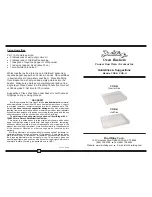
13
Customer Service:
1-877-777-8042
Food Preparation and Reheating Tips
Preparation Guidelines for
Hard Cheeses:
To keep cheese fresh, vacuum seal it after
each use. Make your FoodSaver
®
Bag
extra long, allowing one inch (2.54 cm) of
bag material for each time you plan to
open and reseal in addition to the three
inches (7.62 cm) room you normally leave
between contents and seal. Simply cut
sealed edge and remove cheese. When
you’re ready to reseal the cheese, just drop
it in bag and reseal.
IMPORTANT: Due to the risk of anaerobic bacteria,
Soft cheeses should never be vacuum sealed.
Preparation Guidelines for Vegetables:
Vegetables need to be blanched before
vacuum sealing. This process stops the
enzyme action that could lead to loss of
flavor, color and texture.
To blanch vegetables, place them in
boiling water or in the microwave until they
are cooked, but still crisp. Blanching times
range from 1 to 2 minutes for leafy greens
and peas; 3 to 4 minutes for snap peas,
sliced zucchini or broccoli; 5 minutes for
carrots; and 7 to 11 minutes for corn on the
cob. After blanching, immerse vegetables
in cold water to stop the cooking process.
Finally, dry vegetables on a towel before
vacuum sealing.
NOTE:
All vegetables (including broccoli,
brussels sprouts, cabbage, cauliflower, kale, turnips)
naturally emit gases during storage. Therefore, after
blanching, they must be stored in freezer only.
Thawing and Reheating
Vacuum-Sealed Foods
Always thaw foods in either refrigerator or
microwave — do not thaw perishable foods
at room temperature.
To reheat foods in a microwave in a
FoodSaver
®
Bag, always cut corner of the
bag before placing it on a microwave-safe
dish. However, to avoid hot spots, do not
reheat bone-in meat or greasy foods in
microwave within a FoodSaver
®
Bag. You
can also reheat foods in FoodSaver
®
Bags
by placing them in water at a low simmer
below 170°F (75°C).
Preparation Guidelines for Meat and Fish:
For best results, pre-freeze meat and fish
for 1-2 hours before vacuum sealing in a
FoodSaver
®
Bag. This helps retain the juice
and shape, and guarantees a better seal.
If it’s not possible to pre-freeze, place a
folded paper towel between meat or
fish and top of bag, but below seal area.
Leave paper towel in bag to absorb excess
moisture and juices during vacuum sealing
process.
NOTE:
Beef may appear darker after vacuum sealing
due to the removal of oxygen. This is not an indication of
spoilage.
Содержание FM5400 Series
Страница 1: ...Owner s Manual FM5400 Series ...
Страница 2: ...www FoodSaver com ...






































